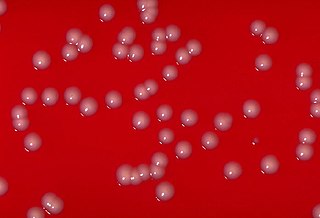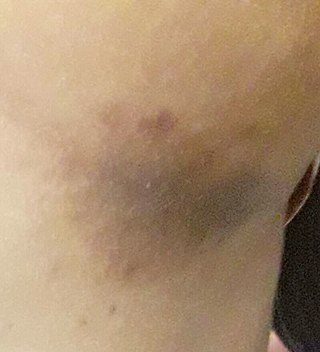
A blacklight, also called a UV-A light, Wood's lamp, or ultraviolet light, is a lamp that emits long-wave (UV-A) ultraviolet light and very little visible light. One type of lamp has a violet filter material, either on the bulb or in a separate glass filter in the lamp housing, which blocks most visible light and allows through UV, so the lamp has a dim violet glow when operating. Blacklight lamps which have this filter have a lighting industry designation that includes the letters "BLB". This stands for "blacklight blue". A second type of lamp produces ultraviolet but does not have the filter material, so it produces more visible light and has a blue color when operating. These tubes are made for use in "bug zapper" insect traps, and are identified by the industry designation "BL". This stands for "blacklight".

Corynebacterium diphtheriae is the pathogenic bacterium that causes diphtheria. It is also known as the Klebs–Löffler bacillus, because it was discovered in 1884 by German bacteriologists Edwin Klebs (1834–1912) and Friedrich Löffler (1852–1915). The bacteria are usually harmless unless they are infected by a bacteriophage that carries a gene that gives rise to a toxin. This toxin causes the disease. Diphtheria is caused by the adhesion and infiltration of the bacteria into the mucosal layers of the body, primarily affecting the respiratory tract and the subsequent release of an endotoxin. The toxin has a localized effect on skin lesions, as well as a metastatic, proteolytic effects on other organ systems in severe infections. Originally a major cause of childhood mortality, diphtheria has been almost entirely eradicated due to the vigorous administration of the diphtheria vaccination in the 1910s.

Corynebacterium is a genus of Gram-positive bacteria and most are aerobic. They are bacilli (rod-shaped), and in some phases of life they are, more specifically, club-shaped, which inspired the genus name.

Intertrigo refers to a type of inflammatory rash (dermatitis) of the superficial skin that occurs within a person's body folds. These areas are more susceptible to irritation and subsequent infection due to factors that promote skin breakdown such as moisture, friction, and exposure to bodily secretions and excreta such as sweat, urine, or feces. Areas of the body which are more likely to be affected by intertrigo include the inframammary fold, intergluteal cleft, armpits, and spaces between the fingers or toes. Skin affected by intertrigo is more prone to infection than intact skin.

Erythrasma is a superficial skin infection that causes brown, scaly skin patches. It is caused by Corynebacterium minutissimum bacteria, a normal part of skin flora.

Corynebacterium renale is a pathogenic bacterium that causes cystitis and pyelonephritis in cattle.

Arcanobacterium haemolyticum is a species of bacteria classified as a gram-positive bacillus. It is catalase-negative, facultative anaerobic, beta-hemolytic, and not motile. It has been known to cause head and neck infections, pharyngitis, and sinusitis.

The Pernambuco pygmy owl is a species of owl in the family Strigidae. This species, first described in 2002, is endemic to Pernambuco state in Brazil.
Lipophilic bacteria are bacteria that may proliferate in lipids.
Corynebacterium jeikeium is a rod-shaped, catalase-positive, aerobic species of Actinomycetota in the genus Corynebacterium. C. jeikeium is pathogenic, typically causing an opportunistic infection seen most frequently in bone marrow transplant patients.
Corynebacterium matruchotii is a species of bacteria in the genus Corynebacterium. Corynebacteria occur within the normal flora of the human body.
Corynebacterium amycolatum is a gram-positive, non-spore-forming, aerobic or facultatively anaerobic bacillus capable of fermentation with propionic acid as the major end product of its glucose metabolism. One of its best known relatives is Corynebacterium diphtheriae, the causative agent of diphtheria. C. amycolatum is a common component of the natural flora found on human skin and mucous membranes, and therefore is an occasional contaminant in human blood cultures but can rarely cause infections such as endocarditis.
Corynebacterium macginleyi is a species of bacteria with type strain JCL-2. It is considered pathogenic.
Corynebacterium efficiens is a thermotolerant, glutamic acid-producing species of bacteria from soil and vegetables. Its type strain is YS-314T.

Corynebacterium glutamicum is a Gram-positive, rod-shaped bacterium that is used industrially for large-scale production of amino acids. While originally identified in a screen for organisms secreting L-glutamate, mutants of C. glutamicum have also been identified that produce various other amino acids.
Lysine Exporters are a superfamily of transmembrane proteins which export amino acids, lipids and heavy metal ions. They provide ionic homeostasis, play a role in cell envelope assembly, and protect from excessive concentrations of heavy metals in cytoplasm. The superfamily was named based on the early discovery of the LysE carrier protein of Corynebacterium glutamicum.

Corynebacterium ulcerans is a rod-shaped, aerobic, and Gram-positive bacterium. Most Corynebacterium species are harmless, but some cause serious illness in humans, especially in immunocompromised humans. C. ulcerans has been known to cause diphtheria and diphtheria-like infections in patients. Previously thought to simply be contaminants recovered from diphtheria patients, “coryneform” or “diphtheroids” are now believed to be the cause of such infections.
Corynebacterium uropygiale is a bacterium described in 2016 following thorough investigations using a polyphasic approach including MALDI-TOF mass spectrometry, phylogeny of 16S rRNA and rpoB genes and DNA fingerprinting. To date, it has been regarded as endemic to preen gland secretions of healthy turkeys . It is a member of the genus Corynebacterium, which belongs to the phylum Actinomycetota. Although a large number of bacteria including corynebacteria have been reported as part of the normal microbiome of birds, C. uropygiale is the only member of the genus that has been recovered in preen gland secretions of birds. It is one of three bacterial species to have been found to colonize preen gland secretions of birds.

Corynebacterium striatum is a bacterium that is a member of the Corynebacterium genus. It is classified as non-diphtheritic. The bacterium is a gram-positive prokaryote that assumes a 'club-like' morphology, more formally known as a corynebacteria structure. It is non-lipophilic and undergoes aerobic respiration and is also a facultative anaerobe it is catalase negative and oxidase positive glucose and sucrose fermenter.

Arceuthobium minutissimum, known as the Indian dwarf mistletoe or Himalayan dwarf mistletoe, is a leafless parasitic plant of Pinus wallichiana. It is considered the smallest known dicotyledonous plant.










